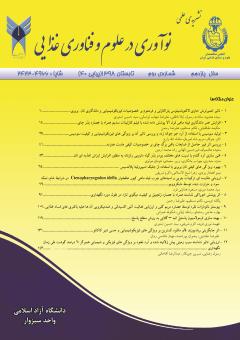بهبود ویژگی های کیفی نان بربری با استفاده از جلبک اسپیرولینا پلاتنسیس
محورهای موضوعی : تکنولوژی مواد غذایی- فرآورده های غلات و پختمینو افتخاری یزدی 1 , زهرا شیخ الاسلامی 2 , اکرم شریفی 3
1 - 1- دانش آموخته کارشناسی ارشد دانشگاه آزاد اسلامی واحد سبزوار، دانشگاه آزاد اسلامی، سبزوار، ایران
2 - 2- بخش تحقیقات فنی و مهندسی کشاورزی، مرکز تحقیقات و آموزش کشاورزی و منابع طبیعی استان خراسان رضوی، سازمان تحقیقات، آموزش و ترویج کشاورزی، مشهد، ایران
3 - گروه علوم و مهندسی صنایع غذایی، دانشکده مهندسی صنایع و مکانیک، واحد قزوین، دانشگاه آزاد اسلامی، قزوین، ایران
کلید واژه: کیفیت, جلبک اسپیرولینا, ماندگاری و نان,
چکیده مقاله :
اسپیرولینا حاوی مقادیر فراوانی پروتئین، کاروتنوئیدها، اسیدهای چرب ضروری، پلی ساکاریدها، ویتامین ها و مواد معدنی است. می توان از آن در جهت رفع نیازهای تغذیه مردم، بوسیله غنی کردن نان بعنوان اصلی ترین غذای مردم استفاده کرد. این پژوهش با هدف بررسی اثر استفاده از جلبک اسپیرولینا پلاتنسیس در بهبود خواص کیفی نان انجام شده است. جلبک اسپیرولینا در 7 سطح به خمیر اضافه شد و خواص کیفی نان مثل حجم مخصوص، تخلخل، رنگ سنجی، ماندگاری و خصوصیات حسی آن ارزیابی شد. نتایج نشان داد که استفاده از اسپیرولینا پلاتنسیس در سطح75/1 درصد سبب افزایش میزان فعالیت آبی در نان شد. استفاده جلبک اسپیرولینا پلاتنسیس در سطح1درصد سبب افزایش میزان کشش پذیری و کاهش سفتی در نان شد.
1.Payan, R. 2005. Introduction to Technology and cereal products, publications AEEJ. (in Persian).
2.Selvam, R. 2002. Calcium oxalate stone disease: role of lipid peroxidation and antioxidants. Urol. Res, 30: 35-45.
3. Gouveia, L., Batista, A.P., Raymundo, A., Sousa, I. and Empis, J. 2006. Chlorella Vulgaris and Haematococcus Pluvialis biomass as coloring and antjoxidant in food emulsions. European food Research and Technology, 222, 362-367.
4. Shetty, k., paliyath, G., pometto, A. and Levin, R.E., 2006, Food Biotechmology, CRC Press, p.498.
5. Gouvia, L., Batista, A.P., Raymundo, A., Bandarra, N.M. 2008. Spirulina maxima and Diacronema; vlkianum microalgae in vegetable gelled desserts. Nutrition and Food Science 38: 492-501.
6. Chronakis, I.S. 2001. Gelation of edible blue-green algae protein isolates (Spirulina platensis): Thermal transitions, rheological properties, and molecular forces involved. Bioresource Technoogyl, 77: 19-24.
7. Gershwin, M.E., Belay, A. 2007. Spirulina in human nutrition and health CRC. Gorobests O., Blinlova L., Baturo A. 2002. Action of Spirulina platensis on bacterial viruses. Zhurnal mikrobiologii, epidemiologii, immunobioligii, 18.
8. AACC-American Association of Cereal Chemists. Approved methods of the AACC. Method 66-50. 10th ed. Minnesota: St. Paul Inc., 2000.
9. Turabi, E., GulumSumnu Sahin, S. Quantitative analysis of macro and micro-structure of gluten-free rice cakes containing different types of gums baked in different ovens. Food Hydrocolloids, 2010;24: 755_762.
10. Fathi, M., Mohebbi, M., and Razavi, S. M. A. Application of image analysis and artificial neural network to predict mass transfer kinetics and color changes of osmotic ally dehydrated kiwifruit. Food and Bioprocess Technology, 2009; DOI: 10.1007/s11947-009-0222-y.11. Gacula, J. R., and Singh. Statistical methods in food and consumer research. Academic press Inc. U.S.A. 1984.360-366.
12. Rajabzadeh, N. 1991. Iranian Flat Bread Evaluation. Pp. 1-50, Iranian Cereal and Bread Research Institute, Publication no.71, Tehran, Iran.
13. Bollaı´n, C. and Collar, C. Dough viscoelastic response of hydrocolloid/enzyme/surfactant blends assessed by uni- and bi-axial extension measurements. Food Hydrocolloids, 2004;18(3): 499–507.
14. Minh, N. P. 2014. Effect of Saccharomyces cerevisiae, Spirulina and preservative supplementation to sweet bread quality in bakery. International Journal of Multidisciplinary Research and Development; 1(4): 36-4415.Belay, A. 2004. New scientific developments in the health benefits of Spirulina (Arthrospira): phycocyanin and its potential health benefits, J Nutritional Sciences;7(3 ):165-173.
16. Salehifar, M., Shahbazyzadh, S., Khosravi-Darani, k., Behmadi, E. 2012. The possibilities of rich cookies by using microalgae Spirulina platensis. Journal of Innovation Science and Technology of Food / year:5, number 3, autumn. (in Persian).
17. Fradique, M., Batista, A., Nunes, M., Gouveia, L., Bandarra, N. and Raymundo, A. 2010.Incorporation of Chlorella vulgaris and Spirulina maxima biomass on pasta products. Part 1: preparation and evaluation. Journal of Science Food Agriculture,90, 1656e1664.
18. De Marco, E. R., Eugenia Steffolani, M., Cristina, S., Alberto, M., León, E. 2014. Effects of spirulina biomass on the technological and nutritional quality of bread wheat pasta. LWT - Food Science and Technology 58 (2014) 102e108.


